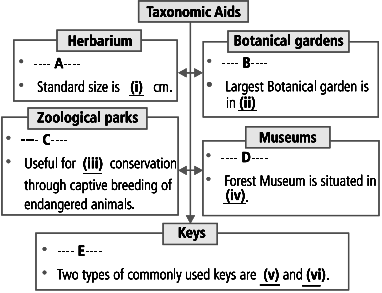Learninsta presents the core concepts of Biology with high-quality research papers and topical review articles.
Taxonomic Aids
Taxonomic aids are the tools for the taxonomic study. Some techniques, procedures and stored information that are useful in identification and classification of organisms are called taxonomical aids. They are required in almost all branches of biological studies for their proper identification and for finding their relationship with others. Some of the taxonomical aids are keys, flora, revisions, monograph, catalogues, herbarium, botanical gardens etc.
Keys
Taxonomic keys are the tools for the identification of unfamiliar plants. These keys are based on characters which are stable and reliable. The most common type of key is a dichotomous key. It consists of a sequence of two contrasting statements. A pair of contrasting statements is known as couplet. Each statement is known as lead. The plant is correctly identified with keys by narrowing down the characters found in plant.
Example:
1.
(a) Flowers cream-coloured; fruiting calyx enclosing the berry …… Physalis
(b) Flowers white or violet; fruiting calyx not enclosing the berry ……… 2
2.
(a) Corolla rotate; fruit a berry ….. Solanum
(b) Corolla funnel-form or salver-form; fruit a capsule: …. 3
3.
(a) Radical leaves present; flowers in racemes; fruits without prickles ….. Nicotiana
(b) Radical leaves absent; flowers solitary; fruits with prickles ….. Datura
Another type of key for identification is the Polyclave or Multi-entry key. It consists of a list of numerous character states. The user selects all states that match the specimen. Polyclave keys are implemented by a computer algorithm.
Taxonomical aids are the collections of samples or preserved organisms which help in extensive research for the identification of various taxonomic hierarchy. Taxonomic studies of various species of plants, animals, and other organisms, which require correct classifications and identification.
Taxonomical aids are the samples or collection of samples of preserved organisms that help in the research of taxonomic hierarchy. The examples are herbarium, monograph, museum, zoological parks, flora, etc. Herbarium is a store that houses plant species or specimens and other related data for study. The most important taxonomical aids are herbaria, botanical gardens, keys, museums, and zoological parks.
Manual:
These provide information for identification of names of species occurring in an area.
Monograph:
These are handbooks which provide the available information of any one taxon. Common taxonomical aids include a herbarium, botanical gardens, zoological parks, museums, keys etc.
Separate taxonomical keys are required for each taxonomic categories like Family, Genus, Species for the identification purpose. The other type of key for taxonomic studies are Flora, Manuals, Monographs and Catalogues. These help in correct identification of organism.
The taxonomic aids are the aids which help in identification, classification and naming of a newly discovered organisms (plant or animal). It could be in the form of preserved document like herbaria or specimen kept at museums or scientific institutions.
Taxonomical aids are the representations or accumulation of samples of preserved bions that help in the study of the taxonomic hierarchy. The examples are herbarium, monograph, museum, zoological parks, flora, etc.
A manual serves as a taxonomic aid by guiding individuals to accurately identify and classify different plants and animals. A manual contains basic but necessary information for categorising plants and animals. The use of a manual is usually user-defined.
A taxonomic key is a device for quickly and easily identifying to which species an unknown plant belongs. The key consists of a series of choices, based on observed features of the plant specimen.it is often referred to as a dichotomous key.
